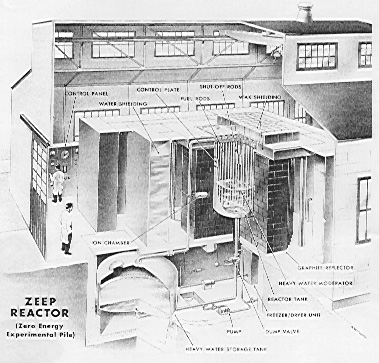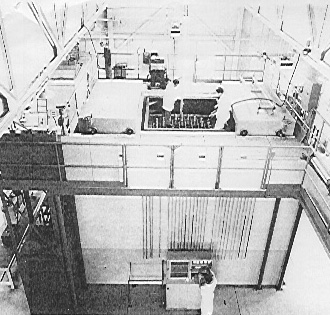
 |
. |
| Cutaway drawing of ZEEP reactor as it was in 1945. (NRC) |
The ZEEP Reactor
A nuclear chain reaction was first initiated in Canada on September 5, 1945, when the ZEEP reactor went into operation at Chalk River. Originally part of an effort to produce plutonium for nuclear weapons, the reactor was designed by a team of Canadian, British and French scientists and engineers assembled in Montreal and in Ottawa in 1942-43 under the administration of the National Research Council. Named Zero Energy Experimental Pile because it was developed to produce only one watt of heat, the ZEEP reactor was used to provide data for the design of the powerful NRX (National Research Experimental) reactor. In 1952 the project was transffered from NRC to Atomic Energy of Canada Limited.
The ZEEP reactor was the first step in the development of the Canadian nuclear reactor system; heavy water moderated, fuelled with natural uranium. The Bruce nuclear power station, now under construction on Lake Huron, is a natural development of the Canadian concept. When completed, its four CANDU reactors will produce more than 3,000,000 kilowatts of electricity for the Ontario Hydro system, making it one of the largest nuclear stations in the world.
ZEEP was the first experimental facility of the Canadian nuclear program, which today includes nuclear power stations, cancer therapy machines, industrial plants for sterilizing medical supplies and a wide variety of research activities, all directed to the peaceful uses of nuclear energy.
 |
Left: An over-top view of
the reactor room. (NRC) Right: Each cylindrical uranium slug weighed about five poounds. Heavy water was pumped into the tank and a chain reaction begun at 3:45 pm, September 5, 1945. (NRC) |
 |
Reprinted courtesy of Atomic Energy of Canada Limited